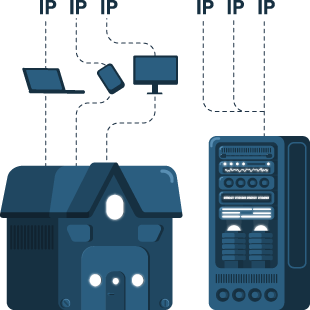Web application performance after introducing a promotion
Discounts are fun and bring more buzz to your web. Test your loads before the big day if you don't want to upset your clients with broken pages during the intense purchasing process.
Must-Try Proxy Server for Load Testing
Make sure your site can handle going viral!
Use a simple gateway to send unlimited requests from different IP addresses and verify that your servers can deal with massive connection loads.

Load testing method examines how your system handles higher loads while simulating greater than usual web traffic. By mimicking real user action, you can spot all the performance limitations in your app, website, or other systems. Early noticed, early fixed!
Load testing can be done with the help of load generators that are paired with quality proxies. The generator simply directs web traffic by sending HTTP requests to your system. Then the target tries to deal with all those requests and return the response.
Proxies act as an intermediary between the generator and the target. Simply, they help to simulate a significant boost in traffic without blocks.
Unlimited connections and threads
55M+ rotating IPs
IPv4, HTTPS addresses
Over 195 countries
Easy proxy setup
Real mobile and desktop devices IPs
Awesome 24/7 customer support
0.61s avg response time
Up to 30 min. sticky sessions
Traffic usage statistics
More load = more stress for the system? Well, not exactly! Load testing shows how your web application behaves when facing higher than usual loads, like DDoS attacks, while stress testing helps measure the maximum limit of the system’s capacity dealing with load.
Performance tests measure the overall system’s behavior from different angles. It shows how the system performs while facing loads and checks the stability levels, response time, and scalability.
Therefore, both load and stress tests fall under the umbrella of performance testing.
Here’s what you get if you roll with Smartproxy:
Human-like traffic is exceptionally important when load testing. Residential IPs win over datacenter proxies in this case. Datacenter IPs are great in terms of stability and speed, but they share the same subnet and don’t simulate the reality-resembling traffic.
Our human-alike residential IPs come from different locations, so they can make your load test as close to reality as you wish.
Discounts are fun and bring more buzz to your web. Test your loads before the big day if you don't want to upset your clients with broken pages during the intense purchasing process.
New and untested applications are like a box of chocolates – you never know if you’ll be the lucky one or end up on a frozen screen. The production stage is the best time to notice and solve possible inconveniences related to enormous loads.
Email-borne attacks are still one of the biggest threats for businesses. During the attack the inboxes are bombarded with thousands of emails making it useless. Knowing your server’s capability of handling email loads could help you to survive such an attack easier.
Pick a plan that suits you. Get ahead with unblockable and stable proxies.
With each plan you access
55M+ ethically-sourced IPs
HTTPS & SOCKS5 support
99.47% success rate
24/7 tech support
Unlimited concurrent sessions
Country & city-level targeting
<0.6s average response time
Rotating and sticky sessions
SSL Secure Payment
Your information is protected by 256-bit SSL
We're thrilled to have the support of our 50K+ clients and the industry's best
Featured in:
A load balancer acts as a distributor by routing the received traffic to different servers to ensure a balanced web traffic load. By doing that the load balancer optimizes the system's capacity to deal with the increased load without affecting performance.
If one of the servers is burned out, the load balancer just shifts the load to others to diminish the effect on the final result.
A load balancer can be considered a reverse proxy that translates the user's HTTP request to a server and then returns the answer. Simply put, reverse proxy aims to increase the scalability and performance of software and ensure computer security.
This testing method stands for analyzing the process of requests and traffic distribution over multiple servers. Such a test shows what can be improved in this process to make the best possible optimization to deal with a huge load. The end goal of load balance testing is to ensure maximum web application availability for the users.




